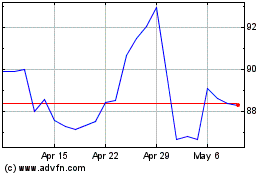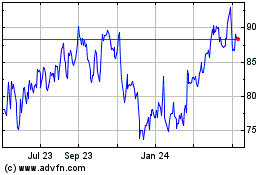By Russell Gold
The U.S. may have even more--and much cheaper to get--supplies
of natural gas than anyone imagined.
Experimental wells in Louisiana by explorers including Comstock
Resources Inc. and Chesapeake Energy Inc. are proving highly
profitable even at today's bargain-basement prices because of the
sheer volume of fossil fuels that can be coaxed out of the
ground.
The trick is applying supersize versions of the
horizontal-drilling and fracking techniques that worked
successfully elsewhere to an area that hasn't seen this approach
yet. The gains come from extending the lateral portions of wells by
thousands of feet and pumping them full of enormous volumes of
sand, chemicals and water to flush out more hydrocarbons.
So far, the impressive results have been confined to a small
area in a single Louisiana parish near the Texas border. But if the
approach works across the giant Haynesville Shale, which spans 120
miles across both states, the era of low American gas prices could
extend for decades into the future, experts say.
"There's a large likelihood that the United States will be
enjoying a very low gas prices for a very long time, maybe 20
years," said Mark Papa, who has monitored Haynesville developments
as a partner at Riverstone Holdings LLC, one of the biggest
energy-focused private-equity firms in the U.S.
The field produces 8% of the nation's natural gas, making it the
second largest after the giant Marcellus Shale in the Northeast.
Because it is located in Louisiana, near several interstate
pipelines, potential export facilities and industrial consumers, an
increase in gas production in the Haynesville has an outsize impact
on gas prices across the entire country.
The cost of natural gas matters because the fuel increasingly
powers the U.S. economy and is a critical to the Obama
administration's push to reduce carbon emissions in electricity
generation. American gas consumption has risen at a 2.4% annual
growth rate for the past decade, while demand for coal has fallen
by 2.7% and oil by 0.7%, according to the federal Energy
Information Administration. Gas now is used to generate about 30%
of U.S. electricity and heat nearly half of all American homes.
Domestic natural gas is abundant and inexpensive, largely due to
the newer drilling and extraction techniques that came into
widespread use a decade ago.
The Haynesville Shale was a popular location for energy
companies to drill in 2007 and 2008, when U.S. gas prices briefly
topped $13 a million British thermal units. Local governments in
Louisiana, flush with tax receipts, handed out bonuses to employees
and built new high-school football fields.
But the region's gas was buried in deep, hot rocks, making it
expensive to produce. When gas prices fell to below $4 a BTU in
2009, drilling rigs moved elsewhere. Some went in search of oil in
North Dakota and Texas; others went northward to Pennsylvania,
where the gas-rich Marcellus Shale was less costly to produce.
But a few companies never left and kept drilling a handful of
wells each year. Recently, Comstock, Chesapeake and closely-held
Vine Oil & Gas LP drilled Haynesville wells that suggest the
gas is economic to exploit at today's lower prices.
Last month, Comstock officials told investors that it could get
a 30% return on its new wells even with gas at $2.50 a million
BTUs. The Frisco, Texas-based company plans to drill more wells in
Louisiana's Haynesville than it will in the oily Eagle Ford Shale
in South Texas.
Comstock shares have tripled since it released news of its new
Haynesville wells. "It was a bold move to return to the Haynesville
and I know there were a lot of doubters out there," Kim Pacanovksy,
an equity researcher at Imperial Capital LLC, said on an investor
call with Comstock management, "but you're starting to see
dividends now, so congratulations."
Chesapeake's management also is heralding its Haynesville
results. Similar to Comstock, the company is drilling gas wells
with longer horizontal legs and using more sand and water to crack
open the rocks. "Applying this technique has really doubled the
area that we can drill in the Haynesville, Jason Pigott, a
Chesapeake executive vice president, told investors.
The costs to hydraulically fracture wells, the process of
pumping water, sand and chemicals into the ground under high
pressure to force out the fossil fuels, have fallen in the past
year. This is particularly evident in the Haynesville, which the
U.S. government classifies it as the second-largest gas deposit in
America behind the Marcellus.
"This is a brilliant example of how the cost of supply continues
to come down," says Robert Clarke, a research director at Wood
Mackenzie, an energy consultant. Newer Haynesville wells are
producing more gas, are larger and are being drilled more quickly,
he said.
Mr. Clarke cautioned that these experimental lower-cost wells
have been drilled in a relatively small area of the Haynesville and
by a small number of companies.
Mr. Papa, the former CEO of EOG Resources, said abundant,
inexpensive gas will have a profound impact on power generation
markets and the overall economy. "The power of the natural gas
story on the U.S. economy is still underrated," he said.
Write to Russell Gold at russell.gold@wsj.com
Subscribe to WSJ: http://online.wsj.com?mod=djnwires
(END) Dow Jones Newswires
September 01, 2015 13:34 ET (17:34 GMT)
Copyright (c) 2015 Dow Jones & Company, Inc.
Chesapeake Energy (NASDAQ:CHK)
Historical Stock Chart
From Mar 2024 to Apr 2024

Chesapeake Energy (NASDAQ:CHK)
Historical Stock Chart
From Apr 2023 to Apr 2024
